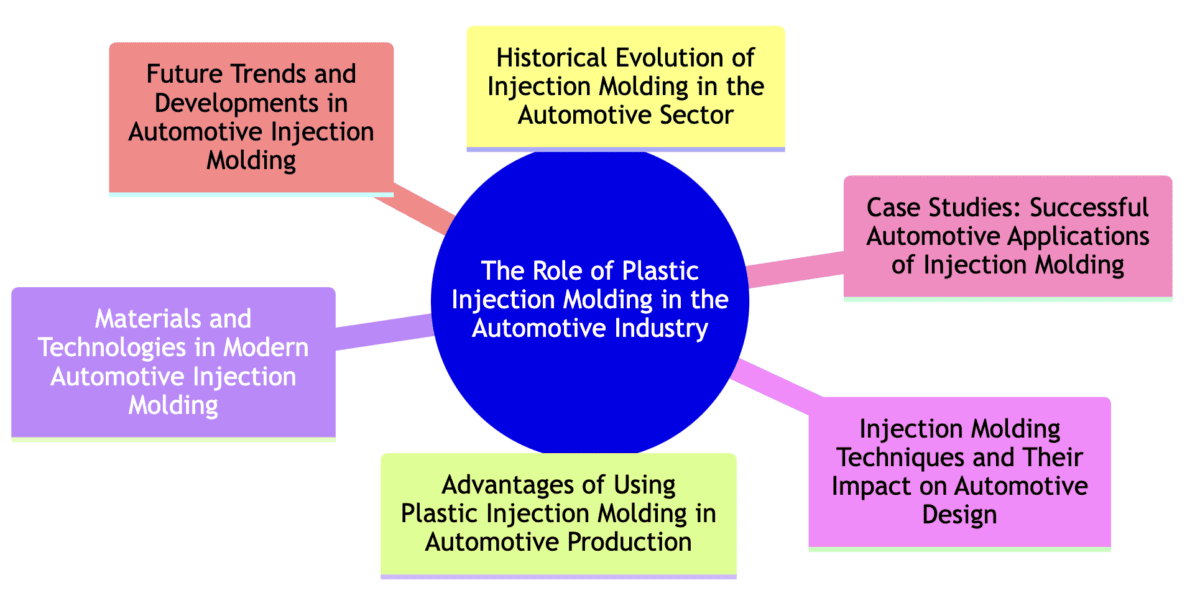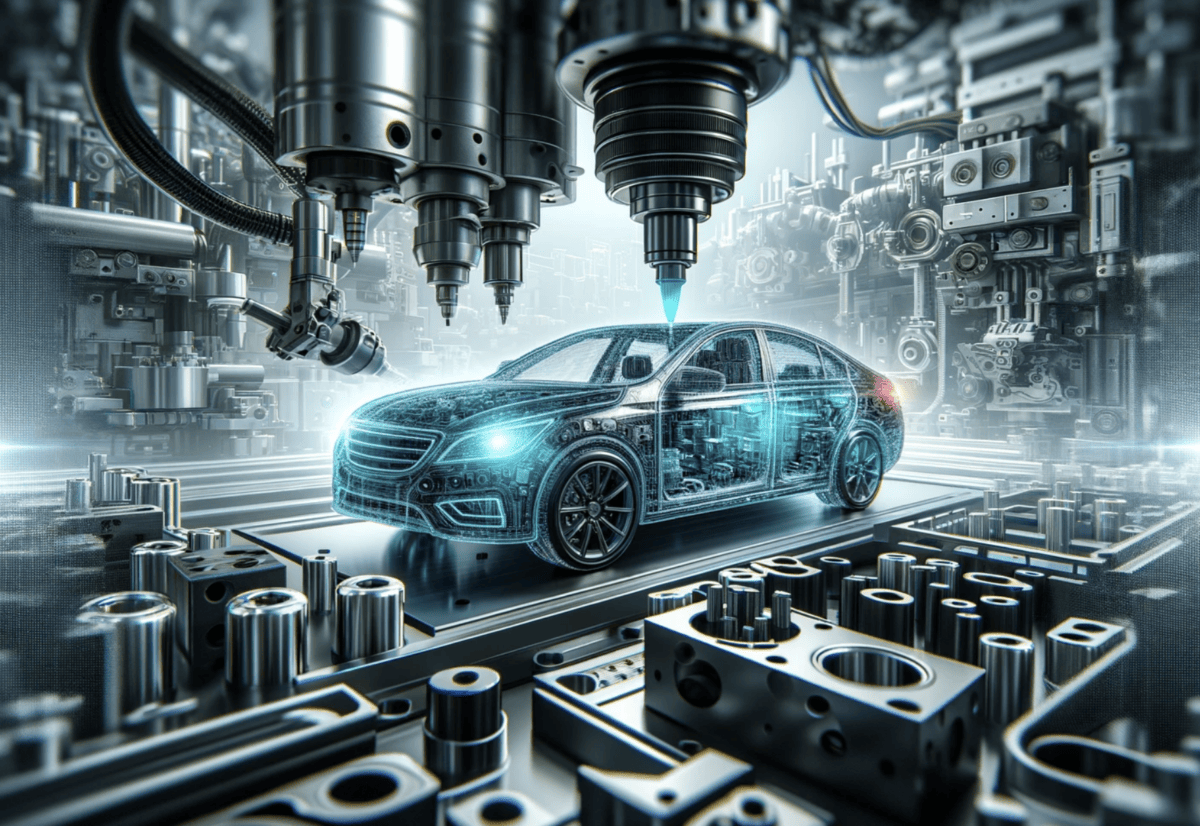Introduction to Plastic Injection Molding in Automotive Manufacturing
Plastic injection molding has revolutionized the automotive industry, offering unparalleled flexibility and efficiency in manufacturing. This process involves melting plastic materials and injecting them into a mold, resulting in high-quality, durable automotive parts. Its significance in the automotive sector is profound, impacting everything from design to production economics.
Key Takeaways
- Versatility in Design: Injection molding allows for complex shapes and sizes, enabling innovative vehicle part designs.
- Cost-Effectiveness: Reduces production costs significantly compared to traditional manufacturing methods.
- Speed of Production: Enables rapid manufacturing of large quantities of parts.
- Durability and Quality: Consistently produces robust parts with a long lifespan.
- Sustainability: Offers opportunities for using recyclable materials, contributing to eco-friendly manufacturing practices.

Historical Evolution of Injection Molding in the Automotive Sector
The journey of plastic injection molding in the automotive industry is a tale of innovation and adaptation. Initially, automobiles were predominantly metal-based, heavy, and limited in design flexibility. The introduction of plastic components in the 1940s marked a significant shift. This period saw the first use of plastic for non-structural, aesthetic parts. However, in the late 1970s and early 1980s, plastic injection molding began to replace other manufacturing processes for a broader range of auto parts, including critical components like dashboards and bumpers.
The real game-changer came in the early 2000s with the introduction of structural plastic components. These parts were not only lighter than their metal counterparts, leading to improved fuel efficiency, but also offered greater design freedom. This evolution has positioned plastic injection molding as a cornerstone of modern automotive manufacturing, driving innovation while maintaining cost and efficiency.
Advantages of Using Plastic Injection Molding in Automotive Production
Plastic injection molding stands out as a highly efficient, cost-effective, and versatile manufacturing process in the automotive industry. It allows for high precision production of complex shapes, which is essential for the intricate designs of modern vehicles. The process is also faster and more consistent than traditional manufacturing methods, leading to increased productivity and reduced time-to-market for new models.
Benefits of Injection Molding in Automotive Manufacturing
The table below illustrates these advantages in a clear, comparative format, highlighting how plastic injection molding is transforming automotive production.
| Advantage | Description |
| Cost Efficiency | Lower overall production costs due to efficient processes and material usage. |
| Quality and Consistency | High precision and consistency in part production, meeting strict industry standards. |
| Design Flexibility | Ability to produce complex shapes and intricate designs, enhancing vehicle component aesthetics and functionality. |
| Material Variety | Wide range of plastic materials available, each suited for different parts and purposes. |
| Metal Conversion | Using plastic as a replacement to metal provides weight savings, part consolidation opportunities, and corrosion resistance. |
| Sustainability | Growing use of recyclable materials, contributing to environmentally friendly manufacturing practices. |
By leveraging these benefits, plastic injection molding is not only enhancing the automotive manufacturing process but also shaping the future of vehicle design and production.
Materials and Technologies in Modern Automotive Injection Molding
The landscape of automotive injection molding is rich with a variety of materials, each bringing unique properties to the table. Materials like ABS (Acrylonitrile Butadiene Styrene) and polypropylene are commonly used due to their durability, flexibility, and cost-effectiveness. ABS is known for its toughness and impact resistance, making it ideal for dashboard components and exterior panels. Polypropylene, on the other hand, is favored for its fatigue resistance and insulating properties, often used in under-the-hood applications and interior trims.
Key Materials and Their Applications
- ABS: Used for dashboards, panels, and exterior body parts due to its strength and durability.
- Polypropylene: Ideal for interior trims, battery casings, and bumpers, known for its fatigue resistance.
- Polycarbonate: Utilized in headlight lenses and door handles for its clarity and impact resistance.
- Polyamide (Nylon): Applied in engine covers and gears, valued for its heat resistance and strength.
- Thermoplastic Polyurethane (TPU): Used in flexible components like tubes and seals, praised for its elasticity.
Technology in Modern Injection Molding
Modern injection molding technology has advanced significantly, integrating cutting-edge innovations for enhanced efficiency and precision. Key developments include the use of computer-aided design (CAD) and computer-aided manufacturing (CAM), enabling the creation of highly accurate and complex part designs. Additionally, incorporating automation and robotics has streamlined the production process, reducing human error and increasing output.
The industry is also seeing a rise in smart sensors and IoT (Internet of Things) technologies, which monitor and optimize the molding process in real-time. These technological advancements have improved the quality and consistency of injection-molded parts and opened new possibilities in material usage and product customization. (1)
Injection Molding Techniques and Their Impact on Automotive Design
Injection molding techniques have evolved, offering diverse ways to meet the intricate demands of automotive design. Each technique brings a unique aspect to the manufacturing process, influencing the final product’s functionality and aesthetics.
Overmolding
Overmolding involves molding a second layer of material over a pre-molded part. It’s used to add soft-touch surfaces on hard plastic parts, handles and control knobs, enhancing grip and comfort.
Insert Molding
Insert molding incorporates metal or other components into plastic parts during the molding process. This technique is crucial for creating parts like electronic housings with integrated metal contacts, ensuring durability and electrical conductivity.
Gas-Assisted Injection Molding
This technique involves injecting gas into the mold cavity to create hollow sections in plastic parts. It’s used for larger components like door handles, reducing weight without compromising strength.
Micro Injection Molding
Micro injection molding is used for producing small, precise components like sensor housings and connectors. This technique is vital for intricate parts requiring high precision.

Case Studies: Successful Automotive Applications of Injection Molding
Injection molding has been instrumental in advancing automotive manufacturing, with numerous success stories. Injection molding has proven its versatility and efficiency, from small components like clips and fasteners to larger parts like bumpers and dashboards.
Real-World Applications and Performance Comparison
- Dashboard Components: Injection molding allows for the integration of complex shapes and textures, enhancing both aesthetics and functionality.
- Door Panels: Molding techniques enable the creation of durable, lightweight door panels with integrated electronic controls.
- Air Vents: Precise molding techniques are used to create intricate air vent designs, ensuring efficient airflow and temperature control.
- Bumpers: Injection molding produces robust and resilient bumpers, capable of absorbing impacts while maintaining structural integrity.
- Headlight Housings: This technology is used for crafting clear, durable headlight housings that withstand environmental elements and provide optimal lighting.
- Engine Components: Molding is crucial for creating various engine parts, offering heat resistance and durability essential for engine performance and longevity.
| Traditional Manufacturing | Injection Molding |
| Limited design flexibility | Enhanced design possibilities with complex shapes |
| Higher material wastage | Efficient material usage, reducing waste |
| Longer production times | Faster production cycles, increasing efficiency |
| Inconsistent part quality | High consistency and quality in part production |
| Heavier components | Lighter parts, improving fuel efficiency |
Through these case studies, it’s evident that injection molding has not only streamlined automotive production but also opened new avenues for design and innovation, significantly contributing to the industry’s evolution.
Future Trends and Developments in Automotive Injection Molding
The horizon of automotive injection molding is rapidly evolving, with groundbreaking trends shaping the future of this industry. A significant shift is the increasing use of bioplastics, driven by the global demand for sustainable manufacturing practices. These eco-friendly materials reduce the environmental footprint and open new possibilities in automotive design and functionality. The integration of advanced technologies like 3D printing and AI in the molding process is set to further enhance precision and efficiency, leading to smarter and more innovative automotive components.
Upcoming Changes in the Industry
- Bioplastics Revolution: A surge in the use of sustainable materials for environmentally conscious production.
- Advanced Automation: Incorporation of AI and robotics for increased efficiency and precision in manufacturing.
- 3D Printing Integration: Utilization of 3D printing for complex part designs and rapid prototyping.
- Lightweight Materials Focus: Emphasis on developing lighter materials to improve fuel efficiency and reduce emissions.
- Customization and Personalization: Growing trends towards customized automotive parts catering to individual preferences.
Conclusion: The Integral Role of Injection Molding in Automotive Advancements
Injection molding has undeniably become a cornerstone in the automotive industry. Its ability to efficiently produce high-quality, durable, and intricate parts has revolutionized how vehicles are designed and manufactured. This technology has not only enhanced the aesthetic appeal and functionality of automobiles but also significantly contributed to the industry’s shift towards sustainability and innovation.
JDI Plastics stands at the forefront of this evolution, embracing and integrating these advancements into their production processes. Their commitment to adopting the latest trends and technologies in injection molding positions them as a key player in driving the automotive industry forward. As we look to the future, the role of injection molding in automotive advancements remains pivotal, with continuous improvements and innovations shaping the path ahead. JDI Plastics’ expertise and dedication to excellence ensure they remain at the cutting edge of this dynamic field, contributing significantly to the automotive industry’s ongoing transformation.
References:
A Detailed Guide on Automotive Manufacturing Process, Niti Samani, https://www.deskera.com/blog/automotive-manufacturing-process/
